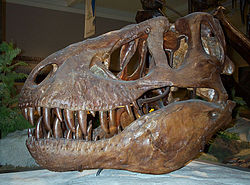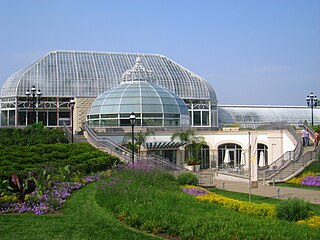
Pittsburgh is a city in the Commonwealth of Pennsylvania and the county seat of Allegheny County. It is the second-most populous city in Pennsylvania after Philadelphia and the 68th-most populous city in the U.S. with a population of 302,971 as of the 2020 census. The city anchors the Pittsburgh metropolitan area of Western Pennsylvania. Its population of 2.457 million is the largest in both the Ohio Valley and Appalachia, the second-largest in Pennsylvania, and the 26th-largest in the U.S. Pittsburgh is the principal city of the greater Pittsburgh–Weirton–Steubenville combined statistical area that extends into two neighboring states, Ohio and West Virginia.

The history of Pittsburgh began with centuries of Native American civilization in the modern Pittsburgh region, known as "Dionde:gâ'" in the Seneca language. Eventually, European explorers encountered the strategic confluence where the Allegheny and Monongahela Rivers meet to form the Ohio, which leads to the Mississippi River. The area became a battleground when France and Great Britain fought for control in the 1750s. When the British were victorious, the French ceded control of territories east of the Mississippi.

Oakland is the academic and healthcare center of Pittsburgh and one of the city's major cultural centers. Home to three universities, museums, hospitals, shopping venues, restaurants, and recreational activities, this section of the city also includes two city-designated historic districts: the mostly residential Schenley Farms Historic District and the predominantly institutional Oakland Civic Center Historic District, as well as the locally-designated Oakland Square Historic District.

North Side refers to the region of Pittsburgh, Pennsylvania, located to the north of the Allegheny River and the Ohio River. The term "North Side" does not refer to a specific neighborhood, but rather to a disparate collection of contiguous neighborhoods.

Downtown Pittsburgh, colloquially referred to as the Golden Triangle, and officially the Central Business District, is the urban downtown center of Pittsburgh, Pennsylvania, United States. It is located at the confluence of the Allegheny River and the Monongahela River whose joining forms the Ohio River. The triangle is bounded by the two rivers.

Allegheny City was a municipality that existed in the U.S. state of Pennsylvania from 1788 until it was annexed by Pittsburgh in 1907. It was located north across the Allegheny River from downtown Pittsburgh, with its southwest border formed by the Ohio River, and is known today as the North Side. The city's waterfront district, along the Allegheny and Ohio rivers, became Pittsburgh's North Shore neighborhood.

The Benedum Center for the Performing Arts is a theater and concert hall located at 237 7th Street in the Cultural District of Pittsburgh, Pennsylvania. Designed by the Philadelphia architectural firm Hoffman-Henon, it was built in 1928 as the Stanley Theatre. The former movie palace was renovated and reopened as the Benedum Center for the Performing Arts in 1987.

The Strip District is a neighborhood in Pittsburgh, Pennsylvania, United States. It is a one-half square mile area of land northeast of the central business district bordered to the north by the Allegheny River and to the south by portions of the Hill District. The Strip District runs between 11th and 33rd Streets and includes four main thoroughfares—Railroad Street/Waterfront Place, Smallman Street, Penn Avenue, and Liberty Avenue—as well as various side streets.

Allegheny Center is a neighborhood on Pittsburgh's North Side. Its zip code is 15212, and it has representation on Pittsburgh City Council by both council members for District 6 and District 1 (Northside).
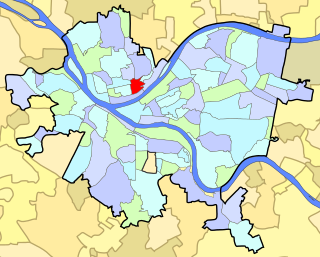
East Allegheny, also known as Deutschtown, is a neighborhood on Pittsburgh's North Side. It has a ZIP code of 15212, and has representation on Pittsburgh City Council by the council member for District 1. The Pittsburgh Bureau of Fire houses 32 engines and 32 trucks in Deutschtown.

The Pittsburgh Cultural Trust (PCT) is an American, nonprofit, arts organization that was formed in 1984 to promote economic and cultural development in Downtown Pittsburgh, Pennsylvania. The "Trust" has focused its work on a fourteen-square block section known as the Cultural District, which encompasses numerous entertainment and cultural venues, restaurants, and residential buildings.
The Cultural District is a fourteen-square-block area in Downtown Pittsburgh bordered by the Allegheny River on the north, Tenth Street on the east, Stanwix Street on the west, and Liberty Avenue on the south.
Männerchor or Maennerchor is the name given to German social clubs, primarily in the northeastern United States, Pennsylvania in particular. The earliest forms of these clubs where "singing societies" that perpetuated traditional choral music, both German and German-American culture, providing Gemuetlichkeit for new immigrants. Such clubs are typically attended by men and many function as a restaurant and bar, serving German foods and beers.

Heinz Hall is a performing arts center and concert hall located at 600 Penn Avenue in the Cultural District of Pittsburgh, Pennsylvania. Home to the Pittsburgh Symphony Orchestra (PSO) and the Pittsburgh Youth Symphony Orchestra, the 2,676 seat hall presents about 200 performances each year. Originally built in 1927 as Loew's Penn Theatre, the former movie palace was renovated and reopened as Heinz Hall in 1971.
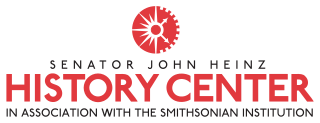
The Senator John Heinz History Center, an affiliate of the Smithsonian Institution, is the largest history museum in the Commonwealth of Pennsylvania, United States. Named after U.S. Senator H. John Heinz III (1938–1991) from Pennsylvania, it is located in the Strip District of Pittsburgh.

The Teutonia Männerchor Hall is a historic American building that is located in the Deutschtown neighborhood of Pittsburgh, Pennsylvania.

The Carnegie Free Library of Allegheny is situated in the Allegheny Center neighborhood of Pittsburgh, Pennsylvania. It was commissioned in 1886, the first Carnegie library to be commissioned in the United States. Donated to the public by entrepreneur Andrew Carnegie, it was built from 1886 to 1890 on a design by John L. Smithmeyer and Paul J. Pelz.
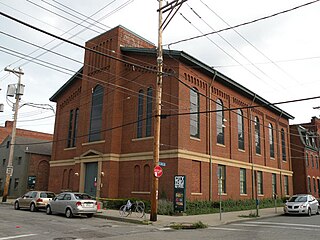
City Theatre is a professional theater company located in Pittsburgh's South Side. It specializes in productions of new plays and has commissioned new works by playwrights on the national theatre scene, including Christopher Durang, Adam Rapp, and Jeffrey Hatcher. Established in 1975 as the City Players under the direction of Marjorie Walker, it was originally composed mainly of Carnegie Mellon graduates and was part of Pittsburgh's Department of Parks and Recreation, performing at schools, parks, and housing projects. Initially the group shared their performance space in the North Side's Allegheny Center with Pittsburgh Public Theater. In 1979, the group was offered a residency at the University of Pittsburgh and renamed itself City Theatre. “Homeless” for a brief period of time, the University of Pittsburgh theatre department offered to shelter the theater company in 1980. Attilo Favorini, head of the department, thought that, “The City Theater offered us [Pitt] the opportunity for Pitt’s students to work a professional company.”(Steele, Bruce “Artistic Struggles -The City Theater Company: A History of Bad Luck and Good Theater” pg. 27) In addition to receiving a new troupe of professional actors, arts funding through CETA enabled the expansion of the company and the creation of the Three Rivers Shakespeare Festival in the summer of 1980. In 1981, under the artistic direction of Marc Masterson, the company moved to a new performance space on Bouquet Street in Oakland. The company again moved to a new performance space at the former Bingham United Methodist Church in the South Side in 1991, where in addition to its own season it acted as a host space for the earliest productions of the Pittsburgh New Works Festival. Marc Masterson became artistic director of Actors Theatre of Louisville in Kentucky, and Tracy Brigden became artistic director in 2001.
The following is a timeline of the history of the city of Pittsburgh, Pennsylvania, US.






